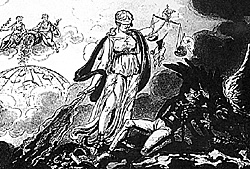 In his book Representations of Revolution (1789-1820), Ronald Paulson outlines three stages that the French Revolution underwent and traces its increasing loss of support in England and other foreign nations. The first phase ran from 1788 to early 1792, when the National Assembly declared itself dissolved into the Legislative Assembly. It included the meeting of the Estates General, the formation of the National Assembly, the storming of the Bastille, the peasant uprisings ("The Great Fear" of the summer of 1789), and the crown's steady loss of control and inability to dissolve the National Assembly.
In his book Representations of Revolution (1789-1820), Ronald Paulson outlines three stages that the French Revolution underwent and traces its increasing loss of support in England and other foreign nations. The first phase ran from 1788 to early 1792, when the National Assembly declared itself dissolved into the Legislative Assembly. It included the meeting of the Estates General, the formation of the National Assembly, the storming of the Bastille, the peasant uprisings ("The Great Fear" of the summer of 1789), and the crown's steady loss of control and inability to dissolve the National Assembly.
The second phase, which came increasingly under mob control, includes the declaration of war on England by the Legislative Assembly, increasing violent reactions against the church and its clergy, the September Massacres, and the declaration of the republic that urged all nations to overthrow their monarchs. Paulson notes that this phase came to its "logical end in January 1793 with the execution of the king".
The third phase, from 1793 through 1794, is what Paulson refers to as the "dog-eat-dog period". It includes the Reign of Terror and its various purges and counter-purges, and the invasion of France by other nations, the French victory at Valmy and the counter-invasion of other nations by France. The Revolution during this third period seemed like the mythical Titan Saturn, "devouring its own children". It was the period most feared and criticized by those both outside of France and those brave enough to raise their voices inside of France.
There is sometimes added a fourth period to this list, the "Thermidor reaction," or "White Terror" which is really not much more than a bloody denouement leading to the rule of Napoleon.
Three Parts of Napoleon's Life
Similarly, Napoleon's life can also be divided into three parts, the first of which won him almost universal praise, whereas the second and third marked distinct losses in popularity for him both at home and abroad. Included in the first phase is what many considered the "liberation" of northern Italy as well as his "enlightened" invasion of Egypt accompanied by a ship full of scientists and other learned men.
The second phase began with his coup d'etat in 1799 and continued with his rule of France as First Consul.
The third phase began with Napoleon crowning himself Emperor in 1804, which, according to his detractors, initiated an ever-increasing despotic reign in which he sought to do nothing more than satisfy his own pride. This was ultimately self-destructive as the continued conquests of foreign nations eventually led to the disastrous retreat from Moscow in 1812 and the allied invasion of France in 1814, when many of the French people, including his own Marshals, turned against him.
To these three periods could be added a fourth: the hundred day period after Napoleon's escape from Elba. This fourth period ends with the Emperor's final defeat at Waterloo, his exile to St. Helena and death there in 1821.
The Romantic poets' attitudes towards the French Revolution and Napoleon followed virtually parallel trajectories in relation to the three periods noted for each. Beginning with ardor and hope for a new, free and happy world, they quickly lost their enthusiasm as each group passed through the second, and especially the third period. This is illustrated quite convincingly by Simon Bainbridge's book Napoleon and English Romanticism.
Most of the English Romantic poets fought a "defensive war" against Napoleon, waiting for him to act and then responding to these actions. This is particularly true in Byron's "Childe Harold's Pilgrimage" which narrates the protagonist's wanderings across Europe and the thoughts that these locations inspire. Yet some--especially Wordsworth--did go on the offensive by recreating Napoleon in their poetry to achieve their own ends.
Regardless of one's personal opinion of the "Corsican Ogre", there is no doubt, as Bainbridge deftly shows, that Napoleon Bonaparte was a major influence and inspiration for the literature of the period.
More Book Reviews:
Back to Table of Contents -- Napoleon #8
Back to Napoleon List of Issues
Back to MagWeb Master Magazine List
© Copyright 1997 by Emperor's Press.
This article appears in MagWeb (Magazine Web) on the Internet World Wide Web.
The full text and graphics from other military history magazines and gaming magazines are available at http://www.magweb.com